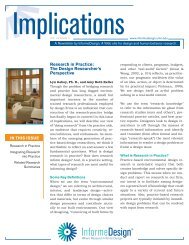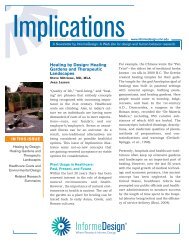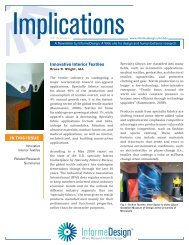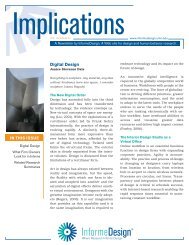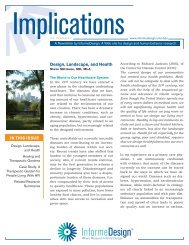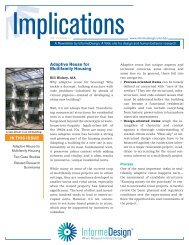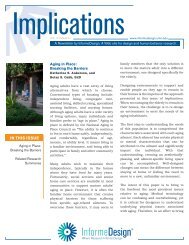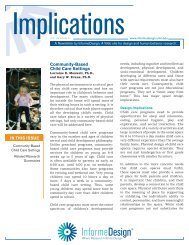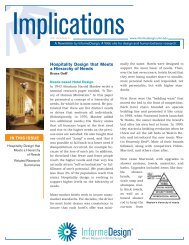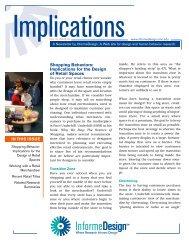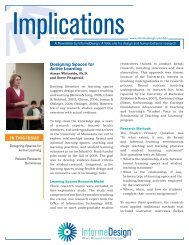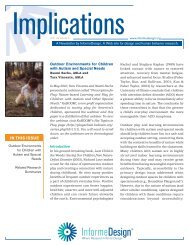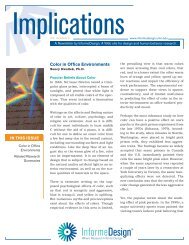Strategies for Designing Effective Restaurants - InformeDesign
Strategies for Designing Effective Restaurants - InformeDesign
Strategies for Designing Effective Restaurants - InformeDesign
You also want an ePaper? Increase the reach of your titles
YUMPU automatically turns print PDFs into web optimized ePapers that Google loves.
Implications<br />
But when anchored tables were broken down by<br />
type, it was clear that booth seats generated higher<br />
spending on average than did other kinds of<br />
anchored tables, while guests seated at banquettes<br />
stayed longer but didn’t spend as much.<br />
Duration and location: time and dollars expended as determined<br />
by seated location as related to an “anchor.”<br />
Of course, these results were from a single restaurant<br />
and it’s premature to generalize these findings<br />
to all types of foodservice operations. However,<br />
designers might take note of the subtle effects that<br />
seat location may have on restaurant per<strong>for</strong>mance<br />
and plan their seating layouts accordingly.<br />
Other design elements that may affect length of stay<br />
include music and lighting. Work with supermarkets<br />
has shown that up-tempo music at about 120 beats<br />
per minute encourages shorter shopping times, and<br />
one restaurant study saw that faster music can contribute<br />
to faster service. Dramatic sound-and-light<br />
elements built into the restaurant experience were<br />
popular additions to heavily themed restaurants in<br />
the 1980s and 1990s, but observations seem to indicate<br />
that patrons tired quickly of these overly stimulating<br />
features. Whether they contributed to faster<br />
meal duration is open to debate.<br />
www.in<strong>for</strong>medesign.umn.edu<br />
4<br />
Conclusion<br />
There is much more work to be done to measure how<br />
guests respond to specific restaurant design decisions.<br />
However, what is known can be applied with<br />
positive outcomes in terms of supporting the restaurateur’s<br />
mission of creating a viable business and<br />
giving customers a reason to come back. By starting<br />
with a frank discussion with the restaurateur about<br />
the intended guest experience and the profile of the<br />
target market, designers can focus on the customer<br />
and then apply what is known about guest behaviors<br />
to the seating layout and other furnishings, fixtures,<br />
and equipment (F, F, & E) decisions to craft an effective<br />
dining environment that corresponds to the<br />
restaurateur’s goals.<br />
References<br />
—Kimes, S., & Robson, S. (2004). “The Impact of<br />
Restaurant Table Characteristics on Meal<br />
Duration and Spending.” Cornell Hotel and<br />
Restaurant Administration Quarterly, 45(4), 333-<br />
346.<br />
—Robson, S. (2002). “A Review of Psychological and<br />
Cultural Effects on Seating Behavior and Their<br />
Application to Foodservice Settings.” Journal of<br />
Foodservice Business Research, 5(2), 89-107.<br />
—Silverstein, M., & Fiske, N. (2003). Trading Up: The<br />
New American Luxury. Portfolio: New York.<br />
—Underhill, P. (1999). Why We Buy. New York:<br />
Simon & Schuster.<br />
—Zaltman, G. (2003). How Customers Think:<br />
Essential Insights Into the Mind of the Market.<br />
Harvard Business School Press: Cambridge, MA.<br />
Where Research In<strong>for</strong>ms Design ®



